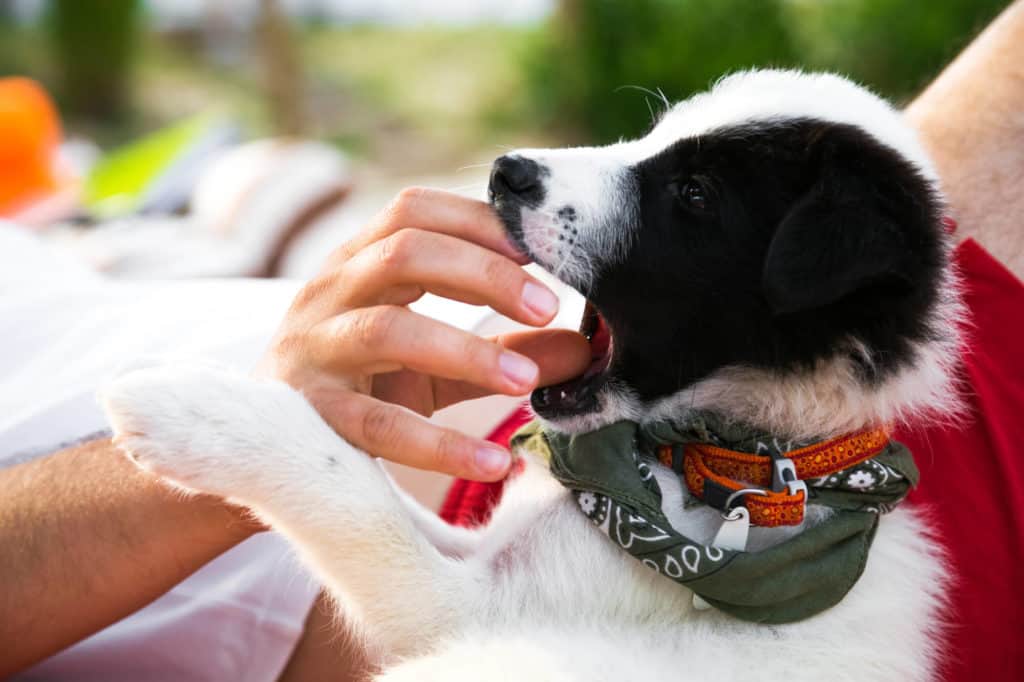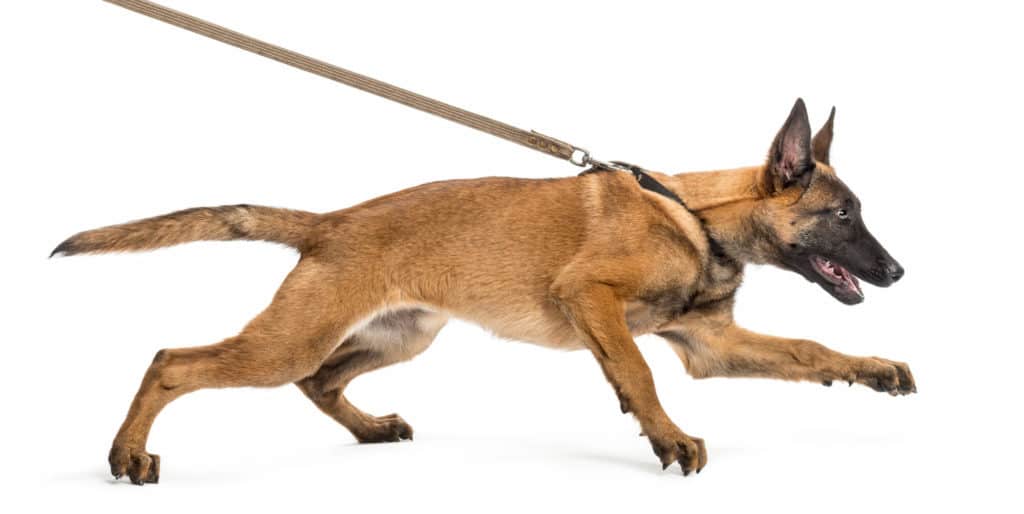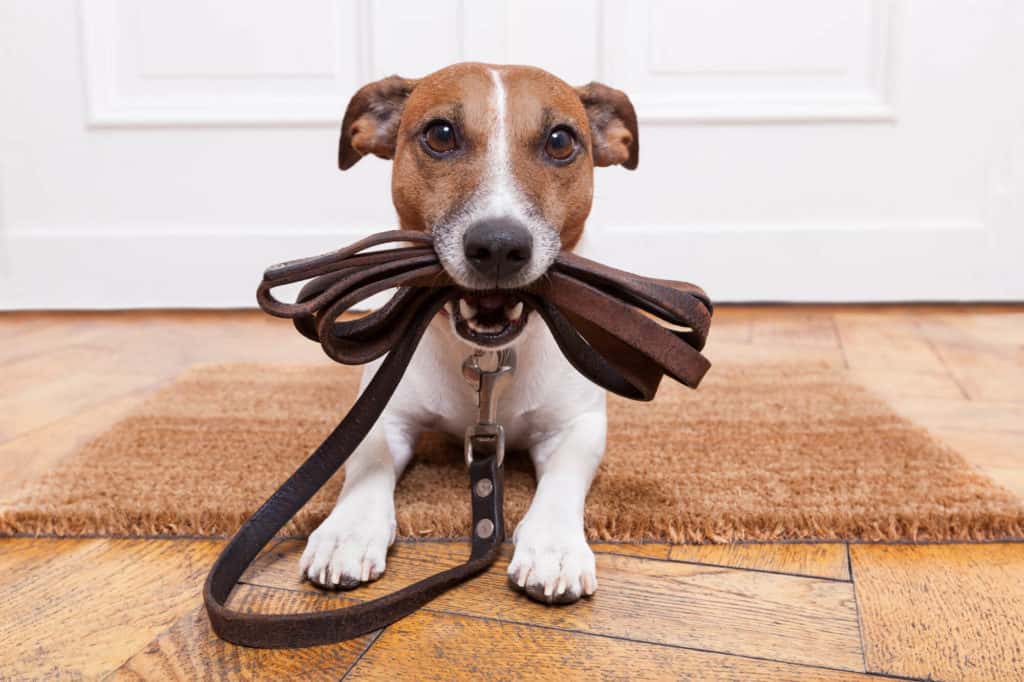When you put the leash on your puppy, it might bite for several reasons that may include negative associations, wrong equipment, or a breed-related reason.
Puppies are curious and have a lot of energy, which is why most of them don't like the feeling of being restrained and are reluctant to put on their leash.
Until you understand why your puppy bites when putting on the leash, you’ll get no rest from the little furball. So, let's go over the reasons behind your pup’s dislike of its leash and how you can address the situation.

Why Does My Puppy Bite When Put on a Leash?
Your puppy has been with you since he was a wee baby. So, it's hard for him to understand why he can't just follow you around wherever you go, which can lead to biting when put on a leash.
There are many reasons puppies may bite or snap at their owners when they're putting on their leashes. These include:
- Leash pulling
- Wrong equipment
- Negative associations
- Dog Breed
Let’s have a closer look at each one.
1. Leash Pulling

Taking a walk with your buddy is all fun and games until he puts on the brakes. What do you do then?
Well, first, don’t pull on the leash! If you’ve done this before, your puppy could be really upset with you.
The first few times you put a leash on your puppy and try to walk it, expect some resistance. Puppies are naturally curious about their surroundings and tend to stop around to explore their environment.
Pulling and dragging a pup can result in many physical as well as mental wounds. You can accidentally injure their necks or give them highly negative experiences.
2. Wrong Equipment
Sometimes, your puppy’s behavior could be the result of discomfort from the collar or leash.
The collar should sit comfortably around his neck so that it won’t cause any chafing by rubbing too harshly on the skin.
Also, the leash shouldn’t be too long. It should be long enough to allow the puppy not to feel restrained, but not too long that he stumbles.
Maintaining the cleanliness of these items is also important for your puppy's health. Any dirt buildup can cause irritation to your pet.
Also, did you know that your dog can be allergic to nylon or metal? It’s quite rare, but certainly not unheard of.
Both of these materials often exist in collars and leashes. They can leave your dog with itchy skin or lesions on the neck area.
Just in case, check around your dog’s neck for any redness, scaly skin, or fur loss. If you find any of those signs, take him to the vet for a quick checkup.
Helpful Dog Training Resource:
For help with training your dog, you should take a look at The Online Dog Trainer by Doggy Dan. Doggy Dan is an expert Dog Trainer based in New Zealand. His online resource contains Hundreds of Excellent Dog Training Videos that will take you step-by-step through the process of developing a healthy, happy well-behaved dog.
3. Negative Connections
It’s possible the puppy’s dislike of the leash may have nothing to do with you. Your pup might dislike the leash because of a negative association he has with it.
That’s to say, dogs have associative memory. They keep their memories by attaching them to certain aspects.
They remember items, people, and places based on the associations they have with them.
Unfortunately, not many dog parents out there are the kindest. Some mistreat their puppies and leave them with trauma.
Hence, if your puppy is a rescue, the sight of a leash can easily trigger those negative emotions.
If your puppy wasn’t at a former home or a dog shelter, he may have learned this behavior through bad experiences with you.
As we mentioned previously, pulling or incorrect equipment can lead to a sad puppy. Moreover, putting on a leash could remind him of a horrible vet visit that he hoped to forget or a visit to a friend that he dislikes!
4. Dog Breed
As most of us know, dogs love the outdoors. They like walking, running, and exploring their environment.
Just like people, however, some dog breeds are a little bit introverted. They're not exactly excited at the idea of putting on that collar and leash to go outside.
It's kind of like stepping out of your comfort zone, and what's not to like about being comfortable?
Also, the streets could be scary sometimes for a wee pup. With loud traffic, joggers running left and right, and odd bird chirps, who could blame the little guy?
Some of these shy puppies include:
Helpful Dog Health Resource:
Note: Our Health is #1 Priority. It should be no different for your dog. But you need to help him. The Ultimate Guide to Dog Health is the answer. This handy guide will help you recognize the symptoms of the health problems above. Get the knowledge to stay ahead of these terrible issues that can rob your lovely dog from vigor and life. Help your friend make it to 14 yrs+ without pain and suffering.
How to Get Your Puppy to Like the Leash
The reasons behind the biting may vary, but so do the answers. If your puppy bites when you're putting on the leash, you can try a few things to get him to stop.

Reward Calm Behavior
First, start by introducing the leash slowly and for short periods at home. Then, depending on his reaction, your actions follow.
If he bites or snaps at you while trying to put it on, you can backtrack and wait for a little bit.
Then, go back later when he's calmer and more relaxed. This will help him associate putting his leash on with good things instead of bad ones!
When he’s calm enough for you to put the collar and leash on him, start flooding the little fella with affection and praise. You can even throw in a small tasty treat!
Repeat this many times until he understands what you expect around the collar and leash.
Play Games Together
You can also play games with your puppy while they're wearing their leash at home. Try tug-of-war or hide-and-seek games.
This way, he won’t feel like he’s being forced into anything unpleasant (like being attached to something or going outside).
Sometimes, you don’t even need to put the collar and leash on. You can just play a little bit of fetch with the leash itself.
Familiarizing the puppy with the gear is essential when it comes to leash training.
The more your puppy is exposed to his leash without being forced to wear it, the more he gets used to having it around without the added stress.

Paul has been creating content for the dog niche for many years. The information he shares comes his first hand experience growing up in dog lovers household and then owning multiple dog breeds of his own as an adult. Paul enjoys doing the hard research to collect, analyze and present our dogtemperament.com readers with the best answers to their questions.